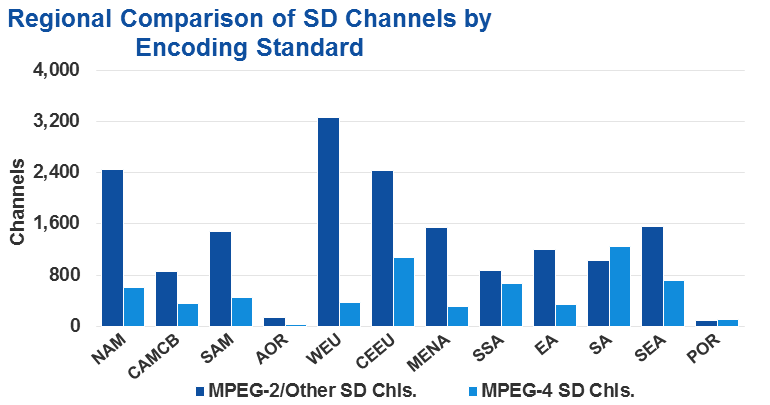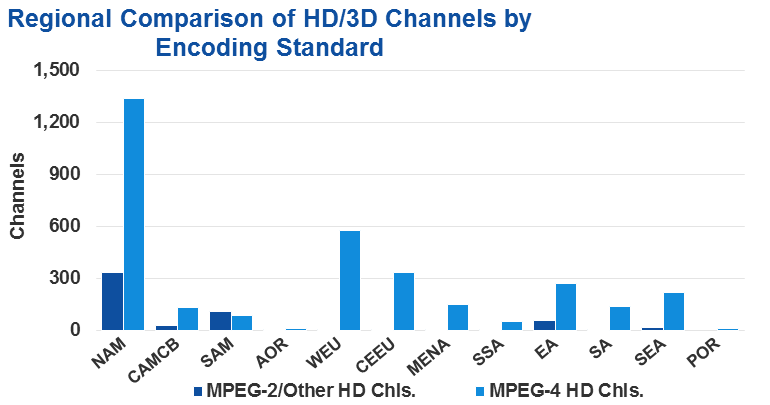Reality Check on MPEG-2
Nov 13th, 2013 by
Patrick French, NST
UltraHD TV and HECV
encoding have been getting a lot of attention in recent
months as the satellite industry tries to understand
how, and how fast, we will get to this exciting new
future of carrying big fat channels over satellite
transponder capacity. It is indeed a subject worthy of
attention, nevertheless it is NSR’s view that the
industry also
needs a reality check on where we stand today in terms
of encoding standards
for carriage of the current crop of SD and HD, as well
as 3D, channels.
For over a decade, NSR has tabulated end-of-year data
for the number of satellite channels carried on each
operational satellite and transponder as part of its
regular market research process. Starting in 2012, NSR
also began to collect information on the encoding
standard employed for each channel, segmenting its SD,
HD and 3D channel counts between channels encoded in
MPEG-2 and similar generation formats (e.g. Conax,
Nagravision) from MPEG-4 encoding. The results of this
effort shed
some light on what is truly begin done in the broadcast
markets today.
 Source
NSR
Source
NSR
Of the 23,182 SD channels NSR attributed to the
global satellite market as of the end of 2012,
fully 73% were still
broadcast in MPEG-2 or another similar format.
This includes all channels carried for C/Ku-band
distribution, FTA, DTT, DTH and other related broadcast
services. Interestingly, one can also see that on a
regional basis, the markets one tends to
think as the “most developed”
such as North America or Western Europe, actually have
the greatest
number of SD channels still being broadcast in the older
MPEG-2 and related formats.
Fully 80% of SD channels in North America and a
staggering 90% in Western Europe used the older encoding
technology compared to regions like Sub-Saharan Africa
or South Asia where about half of the current crop of SD
channels were being carried in MPEG-4.
 Source
NSR
Source
NSR
However, the story is completely inversed when it
comes to HD and 3D channels. Of the 3,836 HD/3D channels
carried globally, no less than 86% were broadcast using
MPEG-4 encoding at the end of 2012. Nearly
all regions were well
over 80%, if not effectively 100%, MPEG-4 for HD/3D
content. Of
course, this is not too surprising as it is the more
efficient MPEG-4 encoding standard that makes HD/3D
content economically viable for the video markets.
Overall, the results of this assessment indicate
something most in the satellite market “instinctively”
understand. New
technology standards generally do not kill markets, but
drive new market opportunities.
The arrival of MPEG-2 digital broadcast led to a quantum
leap in the diversity of channels by making satellite
broadcasting so much more cost effective. The same is
true for HD/3D channel growth being directly linked to
the adoption of MPEG-4, and the industry will almost
certainly see a repeat of the same with
UltraHD’s ultimate success
being directly linked to adoption rates of the HEVC
encoding standard.
Bottom Line
Yet, NSR’s detailed
analysis of the breakout in carriage of SD, HD and 3D
channels between the different standards still raises a
number of issues that lead to challenges/opportunities
that media markets will face in the coming years. These
include:
- Despite
the widespread availability of MPEG-4,
why are so many SD
channels still broadcast in MPEG-2?
Granted, much of this is related to the dynamics of
individual regional markets as well as the sunk cost
in installed bases of MPEG-2 consumer set-top boxes
and IRDs in teleports and headends. But this begs
the question,
is there a market opportunity to force a faster
transition to MPEG-4 for SD content?
Or is it better to
jump straight to HEVC?
And depending on which route the SD channel encoding
migration follows,
how much of the freed up transponder capacity can be
used to support carriage of even more content
without launching new transponder supply?
-
Similarly,
is there an opportunity to move more HD content to
MPEG-4 in a few specific regional markets, notably
North America, East Asia, and South America?
And most especially for South America,
what impact would an HD
migration to MPEG-4 have on the currently tight
capacity situations at the main cable distribution
hot spots?
-
-
Finally, most industry
experts agree that UltraHD is still quite a few
years into the future and the benefits of UltraHD,
especially in terms of capacity leasing, probably
won’t have a substantial impact on operator bottom
lines until the end of the decade. As such, is there
not a much
more significant market
opportunity at least in the short- to mid-term in
teasing out the transition from MPEG-2 to MPEG-4?
(Especially for the huge bulk of SD channels that
still account for the biggest part of capacity
leasing in media markets today.)
In short, yes, UltraHD is great for the satellite
market, and HEVC is certainly a key to success here.
However, instead of focusing so much market energy on
opportunities that are the better part of a decade into
the future, why not put some of that effort into
opportunities already available today?